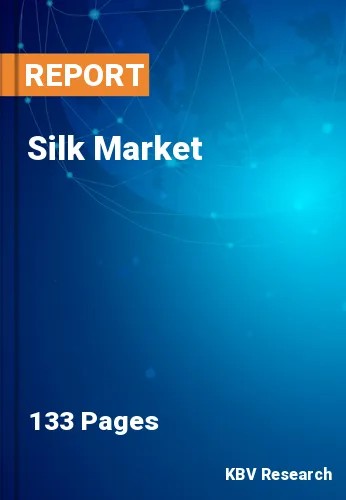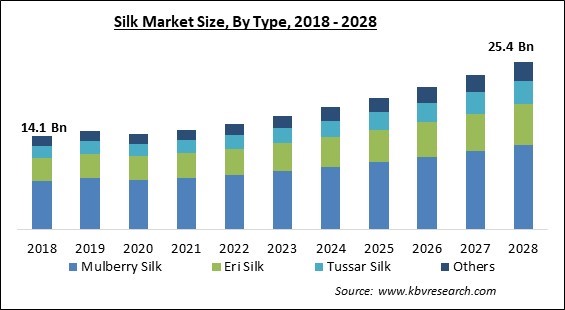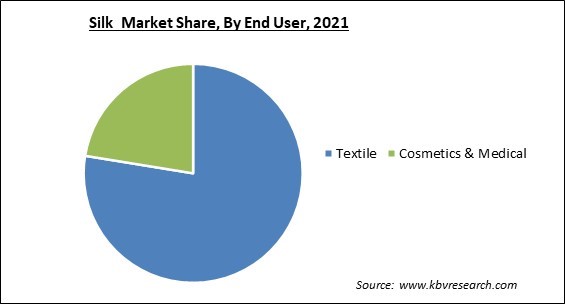
The Global Silk Market size is expected to reach $25.4 billion by 2028, rising at a market growth of 8.0% CAGR during the forecast period.
A natural protein fiber called silk can be woven into certain types of fabric. Fibroin makes up the majority of the protein fiber that makes up silk, which is synthesized by certain larvae to create cocoons. The most well-known silk is made from the cocoons of mulberry silkworm namely, Bombyx mori larvae that are raised in captivity.

The triangular lattice structure of silk fiber, which enables silk cloth to reflect incoming light at various angles and produce diverse hues, is what gives silk its shimmering appearance. The majority of insects that create silk are those whose larvae go through a full metamorphosis, however, some insects, like raspy crickets and webspinners, produce silk all their lives.
Sericulture is the practice of raising silkworms for the goal of producing silk. Sericulture has evolved and been perfected into a precise science throughout the years. Raising productive eggs through the cocoon stage, when the caterpillar is enclosed in its silken cocoon, is known as sericulture. The priceless silk filament is preserved because the chrysalis within is destroyed just before it is able to emerge from the cocoon.
The healthy moths are chosen for breeding and are permitted to mature, mate, and lay further eggs. Typically, a cocoon creates from 1,000 to 2,000 feet of filamentous silk, which is composed primarily of two components, fibroin, and sericin. The other components include wax, salts, and lipids. One yard of silk fabric requires roughly 3,000 cocoons.
The silk market suffered as a result of the coronavirus outbreak. The silk industry experienced a variety of production-related challenges during the COVID-19 period, including fluctuating cocoon and raw silk prices, transportation problems, and a labor shortage. Additionally, a decrease in the trade of raw silk and silk-related products, a decline in working capital and cash flow, fewer export/import orders, and other limitations also affected the overall trade of silk.
Silk has been used as a biological material for surgical sutures. Due to its biocompatibility, mechanical strength, tunable deterioration rate, and ease of loading cellular growth factors (like BMP-2), it has received extensive study and uses as a biomaterial over the past 30 years. These factors also improve the silk’s capacity to be processed into a variety of other formats like films, particles, gels, and scaffolds. Silk's outer sericin covering is removed during a unique manufacturing process, enabling it to be used as a non-absorbable suture for surgery.
Silk is one of the most hypoallergenic textiles available, this makes it a great choice for people with allergies and sensitivities. Silk is naturally resistant to bacteria and fungi, repels dust mites, and functions as a protective covering. Silk fibers are lengthy and gentle, so there is no chance of dermatitis or skin irritation. The many benefits of silk have even led to the prospects for vegan silk. These are mainly drawn from plants' cellulose or from animals were killing them is not needed. Some existing varieties of vegan silk come from ramie plants, orange peel, cotton linter, etc.
Silk is among one of the most expensive natural fibers. It is a difficult fabric to manufacture, and shipping costs make it expensive to transfer silk from its place of origin to the final consumer. Every few months, a website by the name of EmergingTextiles.com publishes reports on the recent prices of silk in China. Chinese silk presently costs from $60 to $65 per kilogram, according to the most recent report. The cost of the Indian silk is likewise monitored and maintained by the Indian government.

On the basis of end user, the silk market is divided into textile and cosmetics & medical. The cosmetic and medicine segment recorded a substantial revenue share in the silk market in 2021. This silk application is still in its infancy and serves a very small portion of the silk market. A natural protein called silk fibroin serves as the basis for many cosmetic products.
Based on type, the silk market is categorized into mulberry silk, tussar silk, eri silk, and others. The mulberry silk dominated the silk market with the highest revenue share in 2021. This is due to the fact that mulberry silk is among the greatest quality silks and that mulberry silk is nourishing to humans owing to the care that is given to the silkworms. Mulberry silk can be used to treat skin disorders including atopic dermatitis because of its antibacterial and hypoallergenic qualities.
| Report Attribute | Details |
|---|---|
| Market size value in 2021 | USD 15.1 Billion |
| Market size forecast in 2028 | USD 25.4 Billion |
| Base Year | 2021 |
| Historical Period | 2018 to 2020 |
| Forecast Period | 2022 to 2028 |
| Revenue Growth Rate | CAGR of 8% from 2022 to 2028 |
| Number of Pages | 133 |
| Number of Tables | 258 |
| Report coverage | Market Trends, Revenue Estimation and Forecast, Segmentation Analysis, Regional and Country Breakdown, Companies Strategic Developments, Company Profiling |
| Segments covered | Type, End User, Region |
| Country scope | US, Canada, Mexico, Germany, UK, France, Russia, Spain, Italy, China, Japan, India, South Korea, Singapore, Malaysia, Brazil, Argentina, UAE, Saudi Arabia, South Africa, Nigeria |
| Growth Drivers |
|
| Restraints |
|
Based on region, the silk market is analyzed across North America, Europe, Asia Pacific, and LAMEA. The Asia Pacific region witnessed the maximum revenue share in the silk market in 2021. China is the main source of the Asia-Pacific region's high demand for silk. Since Asia-Pacific is the region that produces the rawest silk, it has easy access to raw materials. Silk is predominantly utilized in the textile sector. Silk consumption was encouraged by rising textile industry demand. The market for silk is anticipated to continue to grow as a result of technological advancement in the sericulture sector.
Free Valuable Insights: Global Silk Market size to reach USD 25.4 Billion by 2028
The market research report covers the analysis of key stake holders of the market. Key companies profiled in the report include AMSilk GmbH, Bolt Threads, Anhui Silk Co. Ltd., Wujiang First Textile Co., Ltd., Zhejiang Jiaxin Silk Co., Ltd., Shengkun Silk Manufacturing Co., Ltd., Wujiang Wanshiyi Silk Co. Ltd. and Libas Textiles Ltd. (Fresh Group of Companies).
By End User
By Type
By Geography
The global Silk Market size is expected to reach $25.4 billion by 2028.
Use of Silk as A Biomaterial in The Medical Industry are driving the market in coming years, however, Silk Is Expensive to Purchase and Is High-Maintenance restraints the growth of the market.
AMSilk GmbH, Bolt Threads, Anhui Silk Co. Ltd., Wujiang First Textile Co., Ltd., Zhejiang Jiaxin Silk Co., Ltd., Shengkun Silk Manufacturing Co., Ltd., Wujiang Wanshiyi Silk Co. Ltd. and Libas Textiles Ltd. (Fresh Group of Companies).
The expected CAGR of the Silk Market is 8.0% from 2022 to 2028.
The Textile market is leading the segment in the Global Silk Market by End User in 2021; thereby, achieving a market value of $19.2 billion by 2028.
The Asia Pacific market dominated the Global Silk Market by Region in 2021; thereby, achieving a market value of $11.7 billion by 2028.
Our team of dedicated experts can provide you with attractive expansion opportunities for your business.
